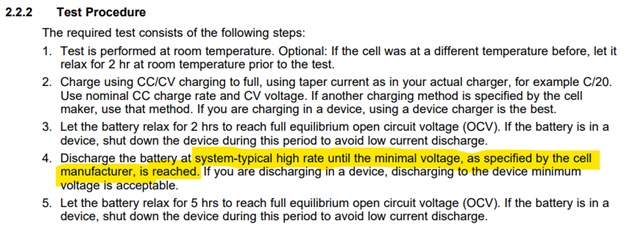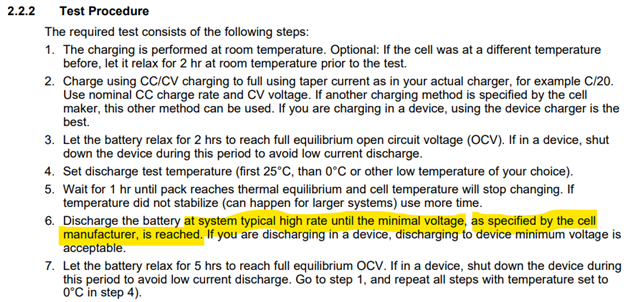Other Parts Discussed in Thread: GPCRB, , GPCRA0
Tool/software:
Dear Sirs and Madams,
We have successfully completed the learning cycle for the BQ34Z100-R2 and am looking to run GPCRA0 and GPCRB.
We have read the respective manuals, but I would like to confirm the current and voltage settings during discharge.
I have a question about the highlighted part of 2.2.2 Test Procedure below:
/* Simple Guide to GPC Golden GG Maker Tool URL */
Simple Guide to GPC Golden GG Maker Tool

/* Golden GG Maker and Resistance Temperature Compensation Optimizer URL */
Golden GG Maker and Resistance Temperature Compensation Optimizer

(1)
Is this discharge current the value at maximum load, or does it mean the typical current value expected in actual use?
If the actual current consumed by the system is quite low, does this mean that the test should be done with a discharge current of 0.01C for a battery capacity of 1C?
It's difficult to define what "at system typical high rate" means. Is there a guideline such as 0.2C to 0.5C?
(2)
Regarding "as specified by the cell manufacturer," the voltage used to terminate discharge in our system is higher than the minimum voltage (discharge end voltage) specified by the cell manufacturer.
Assuming actual use, the discharge end voltage for the learning cycle is also set to a voltage slightly higher than the cell manufacturer's lower limit voltage.
In this case, should I set it to match the value used in actual use?
- Battery dis-charge end voltage spec : 2.25V/cell
- The termination voltage of our system set to BQ34Z100-R2 : 2.75V/cell
(3)
The GPCRB describes low temperatures, but is it because there is little point in running it at high temperatures?
We are considering using our system not only at low temperatures of 0°C and room temperature of 25°C, but also at high temperatures of 45°C.
In this case, do you think it would be better for us to use the GPCRB to run it at high temperatures of 45°C as well?
Regards,
Masashi

